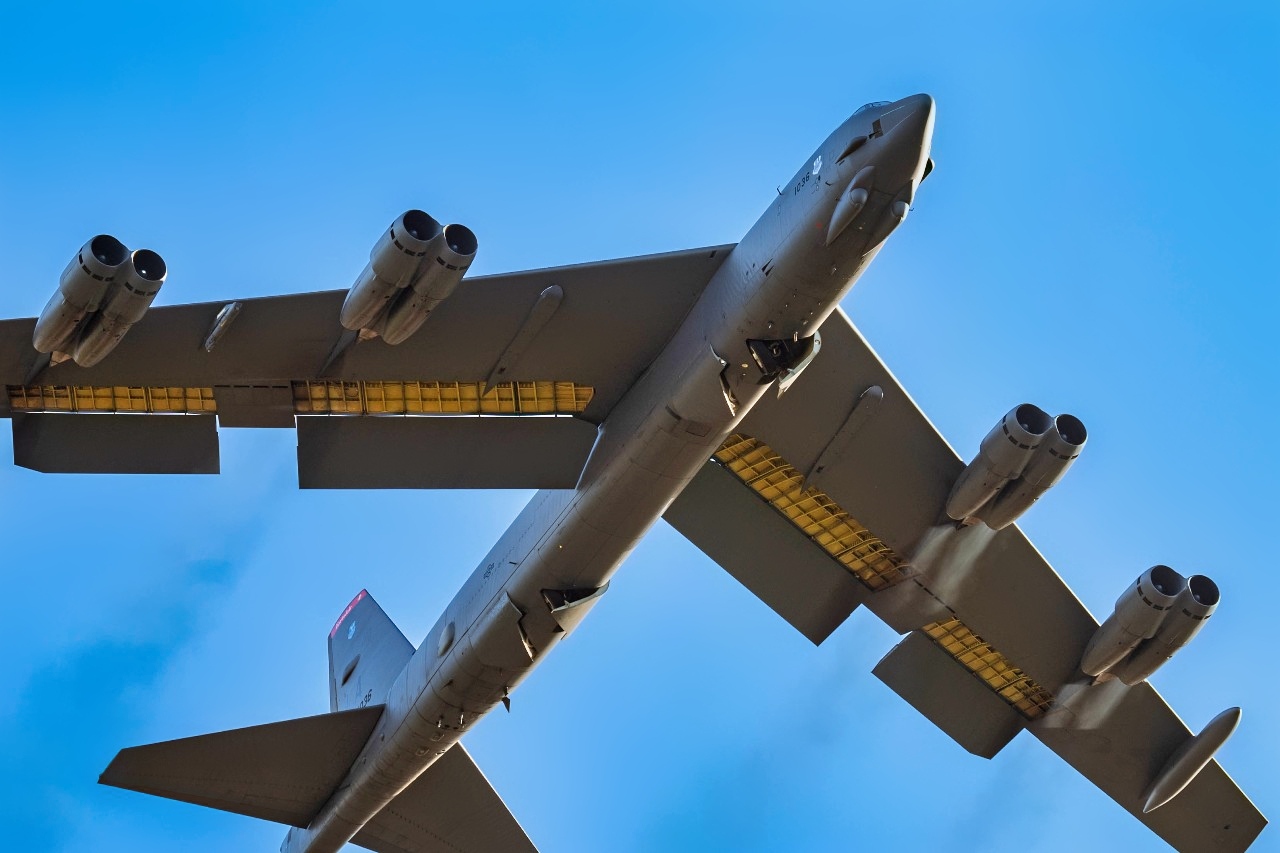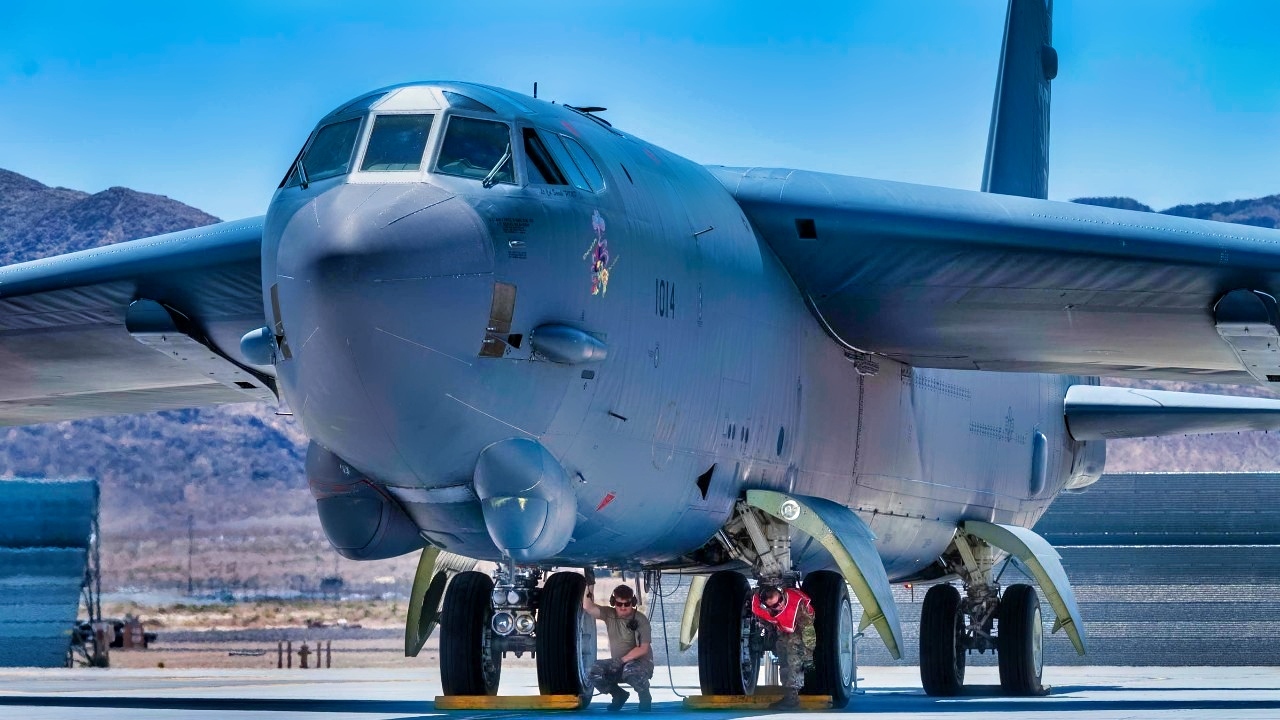Key Points and Summary – The U.S. Air Force’s ambitious B-52J modernization program, intended to keep the bomber flying until the 2050s, is in serious trouble.
-The upgrade, which includes new Rolls-Royce F130 engines and a new AESA radar, is now “significantly behind schedule,” with its operational capability slipping toward 2033.

Military service members, veterans, and citizens of Guam gathered for the Memorial Day Commemoration at the Guam Veterans Cemetery. The Ceremony consisted of a fly over from a B-52H Stratofortress, a musical performance from the Guam Territorial Band & Cantate, guest speaking from the honorable Eddie Baza Calvo, a Fallen Soldier Gravesite Tribute, and the playing of Taps. (U.S. Marine Corps photo by Lance Cpl. Jacob Snouffer/Released)
-A recent GAO report confirms costs are rising, with the radar upgrade alone exceeding its cost ceiling.
-These problems stem from the immense difficulty of integrating modern digital systems into a 1950s airframe, raising the risk that Congress could scrap the B-52J program entirely.
The B-52J Bomber Looks To Be In Trouble
The U.S. Air Force’s ambitious B-52J modernization program, intended to keep the bomber flying until the 2050s, is in serious trouble.
The upgrade, which includes new Rolls-Royce F130 engines and a new AESA radar, is now “significantly behind schedule,” with its operational capability slipping toward 2033.
A recent GAO report confirms costs are rising, with the radar upgrade alone exceeding its cost ceiling.
These problems stem from the immense difficulty of integrating modern digital systems into a 1950s airframe, raising the risk that Congress could scrap the B-52J program entirely.
Will the B-52J Survive Rising Costs?
The U.S. Air Force’s 76-aircraft B-52H fleet – the legendary strategic bomber introduced initially in the 1970s – is slated for its most extensive upgrade in decades under the new “B-52J” configuration.
The effort, conducted mainly at U.S. Air Force depots and Boeing facilities across the United States, aims to keep the aircraft in service through the 2050s.
The program began after a 2021 decision to select the Rolls-Royce F130 turbofan engine for the re-engining effort.
The upgrade was driven by the U.S. Air Force’s need to modernize the aging platform with new engines, radar, wiring, avionics, and digital systems to bring it into the modern era, ensuring it remains relevant in today’s contested environments.

A U.S. Air Force B-52 Stratofortress, assigned to the 5th Bomb Wing, conducts aerial refueling with a KC-135 Stratotanker, assigned the 350th Expeditionary Air Refueling Squadron, June 14, 2024 during a presence patrol mission over the U.S. Central Command area of responsibility. The B-52 is capable of flying at high subsonic speeds, at altitudes of up to 50,000 feet, within the atmospheric tropopause, with worldwide precision navigation capability, providing a unique rapid response to senior coalition leaders globally. (U.S. Air Force photo by Tech Sgt. Ashley Sokolov)
Yet, the program is significantly behind schedule. Initial operational capability was anticipated earlier, but is now slipping toward 2033—and not only that, costs are rising, too.
As the schedule slips and costs rise, the likelihood of the program being scrapped altogether increases—especially given that emerging platforms offer far more for the exact cost.
The Air Force intends to extend this proven platform’s service life rather than replace it wholesale, but unless the program can be brought back under control, it’s unclear whether it has a future.
The B-52J Program and Why It Began
The B-52J initiative is a full-scale modernization package for the B-52H fleet that covers major subsystems and upgrades intended to ensure the airframe remains effective into the mid-21st century.
The core elements of the program include the Commercial Engine Replacement Program (CERP) which will see the Pratt & Whitney engines, which have been out of production since the 1980s, replaced with more modern Rolls-Royce turbofan units.
Simultaneously, the program will see the Radar Modernization Program (RMP) replace the mechanical search radar with an active electronically scanned array (AESA) radar, which will dramatically improve detection, tracking, electronic warfare resilience, and overall situational awareness.
Additional upgrades include new engine pylons, a complete internal rewiring, updated avionics and communication technology, datalink integration, navigation enhancements, and a series of structural and system modifications. The aircraft will also be upgraded to accommodate future weapons systems, including hypersonics or advanced cruise missiles.
The designation “B-52J” will be used to refer to the upgraded B-52H, separating the two variants by decades of technological progress and turning the new version into one that remains relevant as a long-range strike platform for decades to come.

A B-52H Stratofortress assigned to the 20th Expeditionary Bomb Squadron takes off from RAF Fairford, England, for a training mission with the Royal Moroccan Air Force during Bomber Task Force 25-1, Nov. 22, 2024. The U.S. and Morocco’s strategic partnership is based on mutual interests in regional peace, security and prosperity, and we remain dedicated to working together on shared concerns. (U.S. Air Force photo by Senior Airman Mary Bowers)
The program was motivated by several factors. First, the B-52H airframes, which were introduced in the early 1960s, are increasingly showing their age.
Their engines are obsolete and increasingly expensive to maintain, spare parts are challenging to find, and system obsolescence has become a significant risk.
The Air Force judged that replacing the entire fleet with a new bomber now would be far more costly and risky than modernizing what already works.
The re-engining alone promises far greater fuel efficiency and a lower maintenance burden, on top of extended range – all factors relevant to long-range strike and global deterrence missions.
Secondly, the strategic environment has changed. Peer adversaries are now fielding more sophisticated air defenses than ever, better electronic-warfare systems, and more.
The radar and avionics upgrades, therefore, are meant to ensure that this old platform can keep up. After all, a bomber that relies on mid-20th-century warfare systems is a significant risk in the 21st century.
The Air Force is looking to keep the B-52 fleet flying into the 2050s, with a view to ensuring that newer platforms like the B-21 Raider can be fielded in sufficient numbers to replace them eventually.

U.S. Air Force Tech. Sgt. Jacob Durham, left, and Staff Sgt. Kenneth Garris, crew chiefs assigned to the 307th Aircraft Maintenance Squadron, Barksdale Air Force Base, Louisiana, prepare to launch a B-52H Stratofortress in support of U.S. Air Force Weapons School Integration (WSINT) at Nellis Air Force Base, Nevada, June 3, 2025. WSINT serves as the culminating exercise for U.S. Air Force Weapons School students, bringing together air, space, and cyber forces in realistic, mission-critical training scenarios that mirror the complexities of modern warfare. (U.S. Air Force photo by William R. Lewis)
It seems like a big job—and it certainly is—but if the U.S. Air Force is to maintain its congressionally mandated number of operational bombers, this is the most cost-efficient way as long as it remains efficient.
The Risks Ahead
Despite the logic being sound, the B-52J program faces growing scrutiny.
A Government Accountability Office (GAO) report noted schedule slips of up to 3 years across key modernization areas and warned that costs could rise substantially as integration challenges continue to mount.
The radar upgrade, in particular, has already exceeded its projected cost ceiling, forcing the Air Force to justify the overrun. The problems should not come as much of a surprise—they are, after all, working to merge modern digital systems, wiring, and new Rolls-Royce engines into an airframe designed in the 1950s for vastly different components.
Challenges involve compatibility and testing, and every new delay increases the costs for engineering, testing, and contractor labor.
If expenses keep rising, Congress could soon decide that investing billions more into an aircraft from the last century isn’t practical – especially now that the stealthy B-21 Raider is beginning low-rate production.
About the Author:
Jack Buckby is a British author, counter-extremism researcher, and journalist based in New York. Reporting on the U.K., Europe, and the U.S., he works to analyze and understand left-wing and right-wing radicalization, and reports on Western governments’ approaches to the pressing issues of today. His books and research papers explore these themes and propose pragmatic solutions to our increasingly polarized society. His latest book is The Truth Teller: RFK Jr. and the Case for a Post-Partisan Presidency.
More Military
‘Long Way from Production’: China’s J-36 Might Be ‘Paper Tiger’ Stealth Fighter
‘Mach 2’ JAS 39 Gripen Is a Rocket Fighter Plane
New ‘Ferrari’ F-35 Stealth Fighter Is Aimed Right at Russia and China
Putin’s Poseidon Nuclear “Doomsday” Torpedo Looks Like a Bluff
The Air Force’s B-21 Raider Stealth Bomber Plan Doesn’t Make Any Sense










